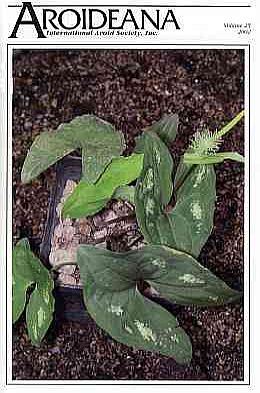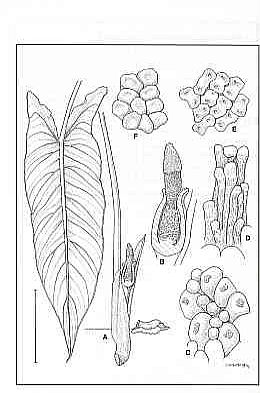|
|



Your search for articles published in volume 25 has found 12 articles.

| 
|
Articles of 3 pages or less are available for free to IAS members for download, and longer articles for $5. Articles from issues in 2016 and beyond are only available electronically, and are free to current members when they are logged in.
Please remember that all Aroideana articles are protected by copyright, and you may NOT distribute even electronic copies without permission from the authors or editor.
(Issue) |
||||
| Eduardo G. Gonçalves, E. R. Salviani | New species and changing concepts of Philodendron subgenus Meconostigma (Araceae) (Buy) | |||
| ABSTRACT: Two new species (Philodendron stenolobum E.G.Gonc. and Philodendron paludicola E.G.Gonc. & Salviani) from the genus Philodendron subgenus Meconostigma are described and illustrated. An updated key for the species is presented and two species formerly considered synonyms of Philodendron bipinnatifidum Schott ex Endl. are here considered as good species (Philodendron lundii Warm. and Philodendron mello-barretoanum G.M.Barroso). | ||||
| Eduardo G. Gonçalves | New aroid taxa from Brazil (Buy) | |||
| ABSTRACT: Six new taxa of Brazilian Araceae are here described and illustrated (Philodendron nullinervium E.G.Gonc.; Philodendron tenuispadix E.G.Gonc.; Taccarum crassispathum E.G.Gonc.; Xanthosoma acutum E.G.Gonc., Xanthosoma rotundatum E.G.Gonc. and Xanthosoma pulchrum E.G.Gonc.). Along with them, a new name (Philodendron humile E.G.Gonc.) is proposed for Homalomena solimoense G.M.Barroso, since this has proved to be a species of Philodendron, and simply transferring the epithet as a new combination in Philodendron is likely to lead to confusion with the pre-existing name Philodendron solimoesense A.C. Smith. | ||||
| Thomas B. Croat, B. Feuerstein | Ulearum donburnsii (Buy) | |||
| ABSTRACT: Ulearum donburnsii, a new species of Araceae, is described from the Amazon lowlands of Ecuador along the RIO Morona in the Province of Morona-Santiago. The species is only the second species in the genus Ulearum. The species differs from the only other species, Ulearum sagittatum Engl., by having filiform staminodes on the spadix on either side of the staminate portion of the spadix, in contrast to the depressed globose or short, cylindric staminodes present in Ulearum sagittatum. | ||||
| Guy Gusman, Van Du Nguyen | Two evergreen species of Arisaema (Araceae) from Vietnam (Buy) | |||
| ABSTRACT: Botanical descriptions of Arisaema balansae Engl. and Arisaema petelotii K. Krause, two Vietnamese evergreen species, are provided with accompanying illustrations. Their taxonomy, distribution, habitat, and cultivation requirements are discussed. Some existing errors in their diagnoses are corrected. | ||||
| M. Hesse | The uniquely designed pollen aperture in Lasioideae (Araceae) (Buy) | |||
| ABSTRACT: The pollen aperture of Lasioideae (sensu Mayo et al., 1997) is a sulcus with two unique characters, seen only in ultrathin sections. A continuous ectexine lamella overspans the whole furrow. Below a thick, bilayered endexine is found. Its outer part consists of isolated flakes or discontinuous lamellae, while the inner part is spongy. The endexine flakes are usually absent in the central sulcus area. This unique aperture stratification is restricted to the Lasioideae. It is absent not only in the other Araceae subfamilies (therefore confirming the homogeneity of Lasioideae), but also not found in any other angiosperm pollen. This peculiarity of all Lasioideae may be correlated with the socalled harmomegathic effect, and as a functional benefit a better preservation from dehydration can be assumed. | ||||
| J. Jacome, Thomas B. Croat | Notes on Monstera minima Madison (Araceae) in Columbia and Panama
This article available FREE to IAS Members with a PERSONAL login. LOGIN, REGISTER or JOIN | |||
| ABSTRACT: Monstera minima is a species described by M. Madison (977) based on a specimen collected by J. A. Duke and had not been recollected until recently. During an aroid inventory (Mora et aI., in press), and study of vertical distribution of epiphytic aroids in forest on the Pacific coast of Choco (Jacome, unpubl. data) individuals of Monstera minima were collected. This species was previously only known from the type specimen in Panama in the Comarca de San BIas and was considered endemic to that country (Madison, 1977). | ||||
| Thomas B. Croat, S. J. Mayo, Julius O. Boos | A new species of Brazilian Philodendron subgenus Meconostigma (Araceae) (Buy) | |||
| ABSTRACT: Philodendron xanadu is described as new. It represents an interesting member of section Meconostigma but differs from other members of that subgenus by its nearly complete lack of posterior lobes and its weakly developed posterior ribs. | ||||
| Alistair Hay | A new Bornean species of Schismatoglottis (Araceae)
This article available FREE to IAS Members with a PERSONAL login. LOGIN, REGISTER or JOIN | |||
| ABSTRACT: The genera of Schismatoglottideae in Malesia have been revised recently (Hay & Yuzammi, 2000; Bogner & Hay, 2000). A subsequent visit to the enormous aroid collection of Arden Dearden at Redlynch in tropical Queensland elicited a new species of Schismatoglottis, Schismatoglottis ardenii A. Hay, sp.nov., which is described here. | ||||
| Yuzammi, Alistair Hay | A new Bornean species of Alocasia (Araceae) from Sulawesi (Buy) | |||
| ABSTRACT: Alocasia megawatiae Yuzammi & A. Hay, sp. nov. is described. | ||||
| J. Hernandez | Notes on the Araceae of Botel Tobago (Buy) | |||
| ABSTRACT: Araceae were observed on Botel Tobago. Ecological observations were made on all species seen. Pollinators were observed and collected from Homalomena philippinensis Engl. Zheng and Lu's (2000) species account for Schismatoglottis kotoensis (Hayata) T. C. Huang, J. L. Hsiao, and H. Y. Yeh is translated. | ||||
| R. S. Misra, M. Nedunchezhiyan, T. M. S. Swamy, S. Edison | Mass multiplication techniques for producing quality planting material of Amorphophallus paeoniifolius (Dennst.) Nicolson (Araceae) (Buy) | |||
| ABSTRACT: Amorphophallus paeoniifolius (Dennst.) Nicolson (Araceae), commonly known as Elephant foot yam, is a high-potential tropical tuber crop. The tubers are a delicacy and rich in nutrients. In India, the cultivar 'Gajendra' is the most popular with non-acrid orange-colored flesh and with a yield potential of 50-60 Metric tons/hectare (tlha). This crop can be grown in other countries also where climatic conditions are suitable. In order to popularize this crop, a huge quantity of planting material is required. The planting material is either small whole tubers or bigger tubers cut into smaller pieces before planting. A large mass multiplication program to produce quality planting material of Elephant foot yam is in operation at our Centre. The mass multiplication techniques were improved and standardized. For commercial cultivation of Elephant foot yam, whole tubers of approximately 400-500 g size with plant to plant and row to row spacing of 90 X 90 cm, were found ideal. To obtain 400-500 g size whole tubers for commercial cultivation, cut tubers of approximately 50-100 g with a plant to plant and row to row spacing of 60 X 60 cm were found suitable for raising the crop for producing the planting material. Major diseases that collectively cause considerable damage to the crop, viz. Mosaic, collar rot, leaf blight and post harvest tuber rot, can be effectively checked by using disease-free planting material. Planting material used for raising the crop for the production of planting material for commercial crop should always be obtained from mosaic free crop and devoid of any post harvest spoilage. A fertilizer dose of 100:80:100 kg/ha of NPK was found to be optimum for raising the crop for commercial cultivation or for producing planting material. Preventive crop protection with two sprays of Mancozeb (0.02%) + Monocrotophos (0.05%) at 60 and 90 days after planting was found very effective. The crop raised for producing the planting material should be harvested only after full maturity and complete drying of the plants. Tuber yields of 30-40 t/ha can be obtained from the crop raised for producing the planting material whereas tuber yield of 50-60 t/ha can be obtained from commercial crop. | ||||
| Dewey E. Fisk | A memorial: Don Burns
This article available FREE to IAS Members with a PERSONAL login. LOGIN, REGISTER or JOIN | |||
| ABSTRACT: It is with deep sadness that we remember the death of Don Burns. Don passed away on April 27, 2002 just prior to his 60th birthday. | ||||
All Images and Text © 1996 to 2024 by the International Aroid Society or by their respective owners as noted.
Please send your comments to
served by aws-web2
